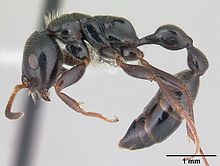Tetraponera
| Tetraponera | |
|---|---|
 |
|
| Tetraponera rakotonis worker | |
| Scientific classification | |
| Kingdom: | Animalia |
| Phylum: | Arthropoda |
| Class: | Insecta |
| Order: | Hymenoptera |
| Family: | Formicidae |
| Subfamily: | Pseudomyrmecinae |
| Genus: |
Tetraponera Smith, 1852 |
| Type species | |
|
Tetraponera atrata Smith, 1852 |
|
| Diversity | |
| 101 species | |
Tetraponera, is a genus of ants, commonly slender ants, in the family Formicidae, and are characterised by their arboreal nature and slender bodies. The 86 described species of Tetraponera all live in hollow structures of plants and trees, such as thorns or branches; these hosts are known as myrmecophytes. Tetraponera species are closely related to the New World genus of ants Pseudomyrmex, but differ in their relationships with host plants.
Tetraponera species are generally defined by the myrmecophytes they inhabit and the mutualistic relationship they share. These host plants always have hollow thorns or branches in which the ants can live and form a colony. Also, the myrmecophytes provide energy rich food sources such as extrafloral nectar and/or food bodies. All Tetraponera species have gut symbionts that allow them to digest amino acid-deficient food provided by their host plants; these gut bacteria are especially important for the species that only survive on the myrmecophyte-provided foods.
All Tetraponera species provide protection for their host plants through aggressive nature towards other insects and trimming leaves/branches of neighbouring plants. Living in hollow structures of the plants allows the ants to detect vibrations when larger insects land on the plant, or workers on patrol visually detect smaller intruders. Once detected, sophisticated pheromone systems allow the ants to quickly outnumber and overpower any invaders. Most insect invaders are killed and discarded by Tetraponera workers such as caterpillars and aphids, but some are killed and consumed. The insects that take the most time and effort to kill are generally consumed; these are mostly katydids or leaf beetles.
...
Wikipedia
